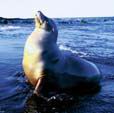|
| Protected Areas
| Adventure Tourism | Beaches
|
 |
Protected Areas
The Galapagos Islands are home to many islands on which tourists can appreciate
and explore the pristine state of the complex, constantly evolving ecosystem
that has made the Galapagos so famous. On the island of Floreana, for
example, you can visit Post Office Bay, The Black Beach, Flamingos Lagoon,
Cormorant Point, or The Pirates’Caves. There are also areas to scuba
dive, such as La Corona del Diablo. On Genovesa, the frigate birds, furry
seals, marine iguanas, tropical birds, red-footed boobies, and masked
boobies all stand out. On Fernandina, there are sea lions, iguanas, pelicans,
penguins, and cormorants. On Española, you can appreciate the dance
of the Blue-footed Booby or the courting of the Albatross.
Other points of interest in the Galapagos Islands are El Géiser,
El Soplador, and Cucubes, all of which are home to a variety of exotic
and rare birdlife. Santiago is well known for having some of the best
and most accessible scuba diving in the Galapagos Islands and also because
it offers the chance to walk between lava flow formations all the way
to the volcanic conic peak of Bartolomé, where furry seals and
sea lions dwell. On North Seymour, there are colonies of frigate birds,
sea lions, and blue-footed boobies. The Plazas Islands are an important
habitat of sea lions, iguanas, cactus, and seagulls. Santa Fe is a bay
surrounded by forests of giant cactus, sea lions, sparrow hawks, and iguanas.
Isabela is home to a nursery of turtles and constant volcanic activity.
In 1998, after twenty years of activity, Volcano Cerro Azul suddenly erupted.
The Galapagos Islands are home to a Marine Reserve which has been declared
a Natural Heritage Site. There are 62 destinations to visit in the islands.
TOP
Sports and Adventure Tourism
In certain areas of the Galapagos Marine Reserve, it is possible to partake
in both deep or shallow diving and to have close-up contact with the impressive
aquatic species of the sea: coral reefs, whales, whale sharks, hammer
head sharks, sting rays, manta rays, sword fish, turtles, and many others.
In the depths of the sea, there are strong ocean currents and the impressive
extrusions of lava that shouldn’t be missed by divers while they
are enjoying the exotic marine wildlife. Other marine habitats are formed
of rocky bottoms, vertical walls, and mangroves. The area is sometimes
affected by natural phenomena, such as cold water currents and the effects
of El Niño.
The Galapagos Marine Reserve encompasses an area of over 133,000 square
km.. Diving in the Archipelago is one of the greatest adventures possible.
The area is considered one of the seven most important regions in the
world for divers. Islands such as Santiago, Bartolomé, and Floreana
(La Corona del Diablo) all offer excellent diving. One of the most interesting
tours passes through the lava formations of the island of Santiago. And
on Santa Cruz, there are trails that wind through the island’s vegetation
of cactus, scrub, and mangroves. On these islands, studied by Charles
Darwin, there are 54 land sites where tourists can go on walks with specialized
guides.
TOP
Sun and Beach/Virgin Beaches
Tortuga Bay, located in Puerto Ayora (Isla Santa Cruz), is one of the
most popular tourist destinations in the Galapagos Islands. It includes
two beaches, separated by a headland of mangroves, each of which is covered
with marble colored sands. On Floreana, on the other hand, there is Playa
Negra, the black lava beach. On the island of Santiago, there are also
beaches ideal for swimming. Other beaches include: Playa Ochoa (San Cristóbal),
Playa Espumilla (Marchena), and Playa Bahía Darwin (Genovesa).
TOP
| Protected Areas
| Adventure Tourism | Beaches
|
|

